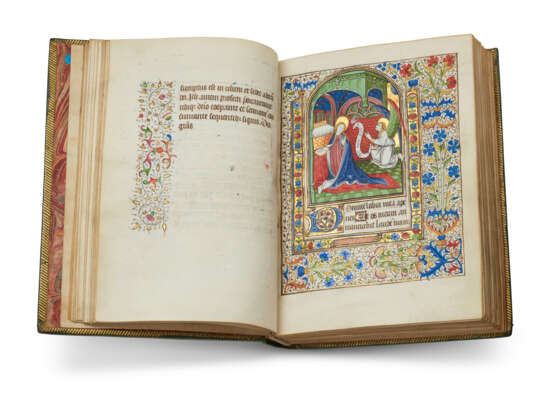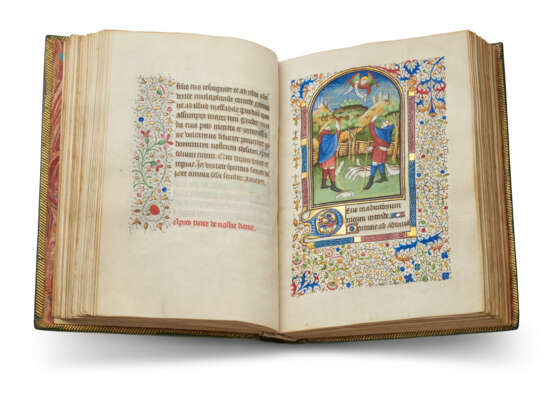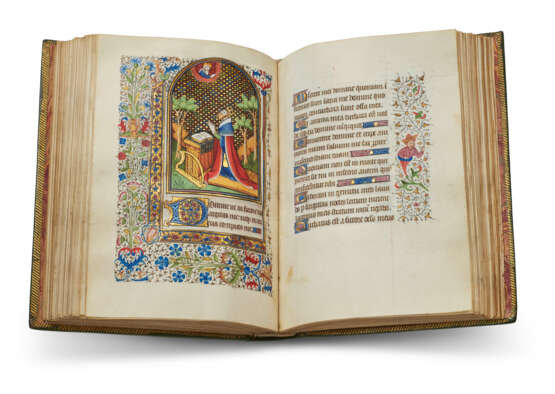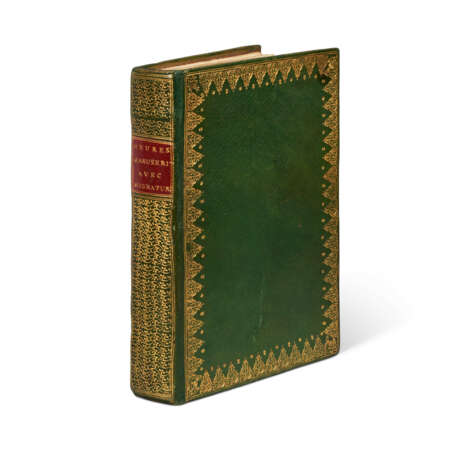ID 993392
Lot 50 | Besançon illuminator (active 1440s-1470s)
Estimate value
£ 50 000 – 80 000
Book of Hours, use of Besançon, in Latin and French, illuminated manuscript on vellum [Besançon, c.1460]
A Book of Hours ‘for love’: pour lamour, the motto below one of the arrestingly attractive miniatures in a glittering volume from Besançon.
230 x 170 mm. i paper + 133 leaves + i paper: 1-36, 4-178, 183, catchwords, complete, unfoliated, 15 lines ruled red, written space: 116 x 77 mm, vertical prickings, rubrics in red, one- and two-line initials and line-endings in gold on divided grounds of pink and blue patterned with white, every page with a border to outer vertical margin for the height of the ruled space of gilded leaves and coloured fleurons on hairline tendrils with a central motif of flowers, fruit, a bird or a grotesque, four three-line initials with foliate infills on burnished gold grounds with gold bars and similar borders to three outer margins, one large miniature below four lines of text with gold bar and similar full border, 16 large miniatures above three-line initials on burnished gold with bars and similar full borders (small paint losses to some faces in miniatures ff.55, 64v, 77v, 81 and to bar f.55). 18th-century French green morocco with foliate border gilt, spine with fleurons gilt over all, red lettering piece gilt, gilt edges, marbled end papers (bands repaired). Box in dark green morocco lettered gilt.
Provenance:
(1) Texts and illumination indicate an origin in Besançon. The sparsely filled Calendar includes in gold Ferreolus and Ferrutio (invention 5 September), who brought Christianity to Besançon, and le pardon st Estienne, the indulgences granted for the anniversary of the dedication of the high altar of the cathedral of St Stephen in Besançon (3 October); red and blue alternate for lesser feasts, including the dedication of the other, now sole, cathedral of St John (5 May), St Deicolus, founder of the Abbey of Lure (17 January), the translation of the relic of St Vincent in Besançon (23 Sept) with his feast in gold (22 January), Valerius of Langres on the date peculiar to Besançon (23 October) and the Bishops of Besançon: Nicetus (8 February), Prothadius (10 February and 19 June), Claude (6 June), Antidus (16 June), Desideratus (27 July), Donatus (7 August). Several of these are invoked in the litany along with other saints of the Franche Comté, as Anatole, Maimbodius and Renobert. The Office of the Virgin follows the Use of Besançon; the short Office of the Dead is found for Besançon among other places. Prayers are in the masculine. Below the Annunciation, f.19, is a scroll with the motto of the first owner: pour lamour, for love.
(2) James Wadmore (1762-1853): armorial bookplate on verso of front endleaf, engraved by Wetton & Jarvis, printers at No.65, Paternoster Row, London; it appeared on one of their trade cards, advertising that book-plates of this ‘stile’ could be engraved for 25 shillings (£1.25 in modern currency, not modern value; British Museum, Heal, 59.179). Wadmore’s collections of paintings, with three notable Turners, and of drawings were sold in these rooms 5-6 and 8 May 1854.
(3) Doris L. Benz (1907-1984) of Lynn, Mass. and North Sandwich, New Hampshire: engraved pictorial bookplate by Charles Sigrist (1892-1955) inside upper cover. A considerable heiress, Doris Benz accumulated a fine collection of books, which she left to be sold to benefit Dartmouth College Library. It was auctioned by Christie’s: the printed books in New York, 16 November 1984, and her three illuminated manuscripts in London, 13 December 1984, with this Hours as lot 129.
(4) German private collection, ms 32; sold Sotheby’s, 20 June 1995, lot 90.
Content: Besançon calendar ff.1-12v; Gospel extracts ff.13-18v; Office of the Virgin, use of Besançon, ff.19-77; Hours of the Cross ff.77v-80v; Hours of the Holy Spirit ff.81-84;Penitential Psalms and Litany ff.84v-101; short Office of the Dead ff.101v-121v; Obsecro te in the masculine ff.121v-124v; O intemerata in the masculine ff.124v-126v; Quinze joies ff.126v-130; Sept requêtes ff.130v-132v; ruled blank with decorated borders f.133.
Illumination:
The style of the luxurious decoration is associated with an illuminator whose activity can be placed in Besançon between the 1440s and the 1470s from his surviving work, mostly in Books of Hours. Many of the miniature compositions in this book are shared with an Hours, also for the use of Besançon, now in The Hague (KB 76 F 12), the starting point for François Avril’s account of his oeuvre (F. Avril and N. Reynaud, Les manuscrits à peintures en France 1440-1520, 1993, no 109). It is not clear how many illuminators worked with him and M. Avril convincingly suggests that the figures in The Hague Hours may not be by his hand. In the Pour lamour Hours, the more elegant figures, with longer, more evenly lit faces, resemble those in a third Besançon Hours attributed to him c.1450 in Châlons-en-Champagne (Bibliothèque municipale ms 333). These figures are closer to the physical types of the Burgundian illuminator identified by M. Avril as a formative influence on our artist, as seen, for instance, in a Besançon Hours in the Morgan Library and Museum (M 293). In other respects, like the framing of the border around the Annunciation, the Pour lamour Hours connects with books by our artist dated to the 1460s from a Psalter-Hours in Vesoul (Bibliothèque municipale, ms 13) illuminated between 1463 and 1467.
His archaising style, which invests his devotional imagery with the appeal and authority of tradition, is marked by a strong sense of surface pattern, reinforced by a liberal use of gold in diapered backgrounds, in decorating textiles and in representing the light of haloes and actual gold objects. Gold is also used for splendidly unexpected elements, like the fencing of the stable and the sheepfold, ff.44v, 50. The emphasis on surface in his lively and expressive scenes accords with the flatness of script and border decoration, sometimes combined with illusions of depth as in the elaborate architectural setting for the Annunciate Virgin f.19. His feeling for line is evident in David’s harp, where the strings unrealistically curve to echo the curve of the pillar and so lack the tension to be playable, f.84v, as seen elsewhere, e.g. in the Hours from the Perrette Collection sold in our rooms in New York, 5 April 2016, lot 466. As was said of that manuscript, his idiosyncratic figures have ‘cheery faces’ and ‘effectively convey a sense of communication one with another’, dark contour lines and strongly delineated facial features giving them an engaging immediacy.
The sparkling gold of the miniatures continues in the borders, present on every page, even the unwritten blanks, a lavish feature of workshop practice that also appears in two of his Books of Hours of the 1460s, along with with many of the same compositional patterns (BnF ms NAL 3118 and The Huntington, HM 1141, the Evangelists only by his hand). The impact of the illumination in the Pour lamour Hours is heightened by the wide clean margins that contribute to the overall effect of this appealingly handsome and generously sized volume.
The subjects of the miniatures are: St John the Evangelist f.13, St Luke f.14v, St Matthew f.16, St Mark f.17v, the Annunciation f.19, the Visitation f.34, the Nativity f.44v, the Annunciation to the Shepherds f.50, the Adoration of the Magi f.55, the Presentation in the Temple f.60, the Flight into Egypt f.64v, the Coronation of the Virgin f.72, the Crucifixion f.77v, Pentecost f.81, the penitent David f.84v, the vigils of the dead: priest asperging the coffin f.101v.
Special notice
No VAT is payable on the hammer price or the buyer's premium for this lot. Please see the VAT Symbols and Explanation section of the Conditions of Sale for further information
| Artist: | Besançon illuminator (XV century) |
|---|---|
| Place of origin: | Western Europe, France, Europe |
| Auction house category: | Medieval & renaissance manuscripts |
| Artist: | Besançon illuminator (XV century) |
|---|---|
| Place of origin: | Western Europe, France, Europe |
| Auction house category: | Medieval & renaissance manuscripts |
| Address of auction |
CHRISTIE'S 8 King Street, St. James's SW1Y 6QT London United Kingdom | |
|---|---|---|
| Preview |
| |
| Phone | +44 (0)20 7839 9060 | |
| Buyer Premium | see on Website | |
| Conditions of purchase | Conditions of purchase |









